Motorcycles
Let’s face it, many, if not most people, do not like motorcycles and, in particular, motorcycle riders. Some of the reasons we have heard is because riders break the law, cut in an out of traffic, ride between traffic, do “wheelies”, and speed off when a traffic light turns green. But most who ride motorcycles are responsible, law-abiding riders and many are business and professional people who ride for pleasure, relaxation, and a sense of freedom. Riding in heavy traffic and on busy roads is potentially very dangerous because riders have no protection if any type of vehicle crashes into them. So, we must ask what motorcycle riders must do to be responsible riders. The answers are simpler than one may think.
Is Motorcycle Riding Dangerous
Motorcyclists are more vulnerable to injury than a driver of a larger vehicle if involved in a crash. Research shows that over two-thirds of car/motorcycle collisions are the result of the other driver turning in front of a motorcyclist. Motorcyclists and cars/trucks need to mix in traffic without causing harm to each other. Motorcycles present a narrow silhouette and are usually much shorter in length than an automobile. The small profile of the motorcycle may make it appear farther away and traveling slower than it actually is. Remember that motorcycles are often hidden in a vehicle’s blind spot or missed in a quick look due to their smaller size. Because it is difficult to judge the motorcycle’s distance and speed, vehicle drivers need to take a second look, and then a third. Its small size also makes it more difficult to spot in traffic than another car. Some motorcyclists take advantage of their small size and maneuverability.
Not all motorcycles are the same. There is a broad range of motorcycles on the market, ranging from off-road to street motorcycles.
How to Make Motorcyclists Safe For Themselves and Motorists
The answers are quite simple:
- Obey all of our traffic safety laws, which apply to all vehicles and motorcycles alike.
- Perform regular motorcycle maintenance.
- Take motorcycle driver safety education classes.
- Wear proper safety clothing: boots that cover the ankles, leather or similarly protective pants and jackets, gloves, and a DOT-approved motorcycle helmet. Not all helmets are alike. The general rule is, if the person drops or damages his/her helmet, replace it before riding again. Don’t wear flip-flops, short pants, and short-sleeve shirts.
- Remember that motorcycles have a low profile and are hard for motorists to see. Assume that the motorists do not see you.
- Be mindful of the weather. Wet roads are slippery, especially when it first begins to rain because the rain has not yet removed the oil and slippery road residue.
- Have your rain gear available.
- Use turn signals or, alternatively, use hand signals when making left and right turns.
- Don’t tailgate.
- Know your motorcycle skill level and experience. Do not ride beyond your ability to ride safely. Not every rider has the same training, experience, and skills.
- Ride in the center of a travel lane, not off to one side or the other.
- Have a State driver’s license motorcycle endorsement.
- Know your motorcycle and its capabilities.
You May Need A Lawyer To Recover Your Damages
Under Louisiana law, a crash victim has one year from the date of injury to file a lawsuit or, if possible, settle the case. When this one-year period expires, the crash victim loses the right to sue the wrongdoer for both economic and non-economic damages.
Most people have no experience with the legal system and dealing with insurance companies. It is important to know that there are two Points of View (POV). The crash victim wants Justice, meaning full compensation. The insurance company wants to pay as little as possible for the injured person’s damages. The community in general POV about motorcycles and their riders is that they are “dangerous, killing machines.” So, if you need an attorney, you want one who cares about you, who spends time getting to know you, who keeps you informed about your case, who spends the necessary time to explain the law, and who knows what evidence is needed to prove all of your damages.
At the Law Offices of Richard R. Kennedy, you will have Richard Kennedy and Richard Kennedy III to represent you. Is this important? You bet? Why? First, together we have nearly forty years of riding motorcycles in many parts of the United States, from flat lands to mountains. Because you will know who is representing you; you know that we will keep you timely informed about your case and all the information you need for us to do our very best to get justice for you. When you call us, we answer your calls and we promptly answer your emails. The bottom line is simple: we and our clients get to know each other on a personal — not just a professional — level. That is critical in building trust. So, if you need a lawyer who is well versed in personal injury and has ridden motorcycles for over 30 years, call us.
Reduced Visibility Increases Risks of Crashes
Navigating Reduced Visibility: Safe Driving
Practices for Challenging Conditions
Driving is a responsibility that requires vigilance, attentiveness, and a keen sense of awareness. When faced with reduced visibility situations, the stakes are even higher. Reduced visibility, caused by factors such as fog, rain, snow, bright sunlight, or even darkness, significantly increases the likelihood of crashes and poses a serious threat to road safety.
What is a Reduced Visibility Situation?
A reduced visibility situation is one where your ability to see and be seen is compromised. These situations can arise due to various weather conditions and environmental factors. Common examples are :
- Fog: Fog can significantly impair your vision, reducing your ability to see the road, other vehicles, and obstacles. It can be particularly dangerous if it rolls in suddenly or is patchy.
- Rain: Rain can create a curtain of water on the windshield, making it challenging to see the road and other vehicles. Heavy downpours can also lead to hydroplaning, where your vehicle loses traction on the wet road surface.
- Snow and Ice: Snow and ice can blanket the road, making it slippery and affecting your control over the vehicle. Reduced visibility can also be caused by blowing snow or sleet.
- Darkness: Nighttime driving inherently reduces visibility. Reduced street lighting in some areas and glare from oncoming headlights can further complicate the situation.
So what should you do when encountering a reduced visibility situation? Some safe driving practices in reduced visibility situations include:
- Slow Down: Reducing your speed is one of the most effective ways to ensure safety in reduced visibility conditions. Slower speeds provide more time to react to unexpected obstacles.
- Increase Following Distance: Keep a safe following distance between you and the vehicle in front. In adverse conditions, the typical three-second rule should be extended to at least six seconds. This extra space allows you more time to react and stop if necessary.
- Use Your Headlights: Turn on your headlights, even during the day, to increase your visibility to other drivers. When in doubt, use your low beams rather than high beams, which can create glare in fog or rain.
- Keep Windows Clear: Make sure all your windows are clean and clear. Use defrosters and windshield wipers as needed to maintain good visibility.
- Use Fog Lights When Appropriate: If your vehicle has fog lights, use them only when visibility is significantly reduced, such as in dense fog or heavy snow.
- Avoid Distractions: In challenging conditions, your full attention should be on the road. Avoid using your phone, eating, or any other distractions that can divert your focus.
- Stay in Your Lane: Follow the lane markings and stay within your lane. Reduced visibility can make it easy to drift out of your lane, so stay attentive.
- Be Cautious at Intersections: Approach intersections with extra caution. Other drivers might not be as visible as they should be, and some may not adhere to traffic rules. Do not assume the other drivers are slowing to a stop or that they even can see the intersection controls.
- Plan Ahead: Before embarking on your journey, check weather forecasts and traffic reports. If conditions are particularly bad/adverse, consider delaying your trip or taking an alternative route.
- Know When to Pull Over: In extreme conditions, when visibility is almost nonexistent, it may be best to pull over to a safe location and wait for conditions to improve.
Conclusion
Reduced visibility situations are a challenging aspect of driving, but with the right practices, you can significantly reduce the risks. Prioritize safety, adapt to the conditions, and always be prepared for the unexpected. By following these safe driving practices, you can protect yourself, your passengers, and others on the road, making our highways safer for everyone, even in the most adverse conditions.
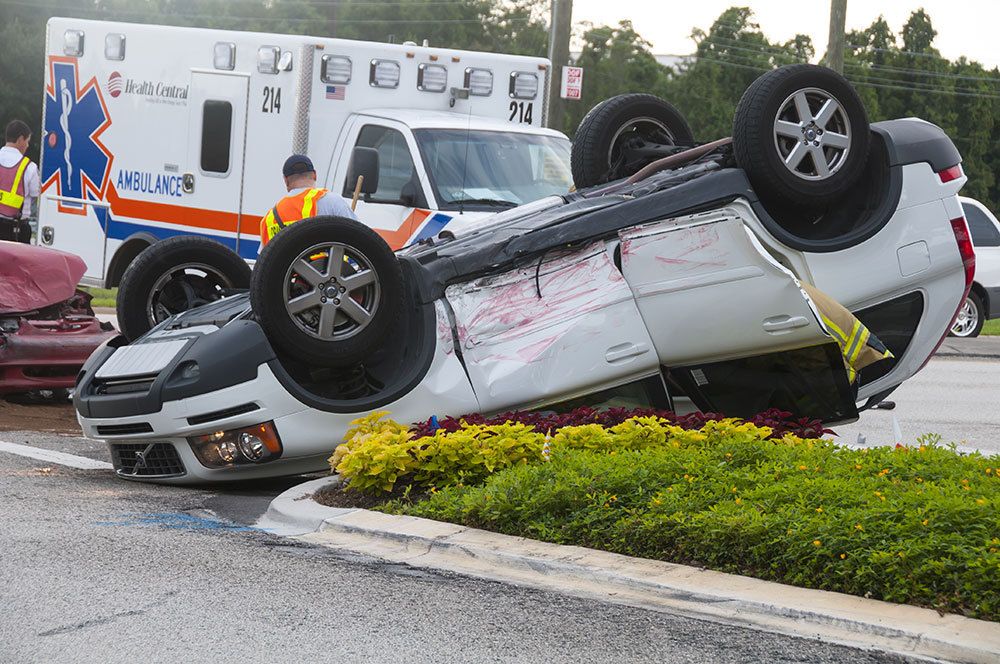
Basic Overview of Louisiana Insurance Law
BASIC LOUISIANA INSURANCE LAW
Car wrecks happen daily:
Vehicular wrecks happen daily, frequently causing serious injuries, death, and property damages. So it’s important to know some basics facts about Louisiana insurance law to know what insurance coverage is legally required and what additional coverages you should consider buying to protect yourself. A reputable insurance agent can help advise you about what coverages and policy limits will best protect you and your family. Honestly, Louisiana insurance law is vast and complex and, as such, this blog only discusses some of the more common auto insurance questions. Insurance liability requirements:
In Louisiana for a single wreck, you need $15,000 in bodily injury liability insurance per person ($30,000 per accident) plus $25,000 in property damage liability insurance to drive legally. These liability insurance requirements can also be written as 15/30/25. Liability insurance does not pay all of your damages. Liability car insurance comes in two forms: bodily injury liability coverage and property damage liability coverage. Bodily injury liability insurance covers expenses related to other parties’ physical injuries caused by your vehicle. Property damage liability insurance pays for repairs to the victim’s damaged property, including a car or a house.Louisiana’s “No-Pay, No-Play” Law:
Under Louisiana’s “no pay, no play” law, an owner or operator of a motor vehicle that is involved in an accident who fails to own or maintain compulsory motor vehicle liability security is prohibited from recovering his or her first $10,000 of bodily injury and his or her first $10,000 of property damage based on any cause or right of action arising out of the motor vehicle accident.
There are some exceptions to Louisiana’s “No-Pay, No-Play” law like, for example:
• It does not apply if you have the required minimum liability insurance.
• It does not apply to legally parked vehicles.
• It does not apply to drivers from another state if their state law does not require them to have liability insurance at the time of the wreck.
• It does not apply if the other driver is convicted of driving while intoxicated, intentionally caused the wreck, fled the scene, or acted in further the commission of a felony when the wreck happened.Comprehensive, Collision, and Uninsured Motorist Coverages:
When you are at fault in an accident, liability insurance coverage does not pay for any damage to your own property. It does not pay your medical bills, either. Liability coverage is not the only type of insurance you should consider. To be fully protected in the event of a wreck, you will need collision coverage, comprehensive, and uninsured motorist (UM) coverages. Statistics show that about one-third of Louisiana drivers have no liability insurance. And many, if not most, carry only the minimum liability insurance limits. Remember, UM coverage protects you and, if the other driver has no insurance or minimum liability insurance and your damages exceed the other driver’s policy limits, you will need your UM insurance to pay or help pay for all of your damages.Does the policy follow the owner or the vehicle:
Speaking generally, a car insurance policy in Louisiana usually follows the car. But you must check your policy’s exclusions — check for things like “insured vehicle” and “replacement vehicle” — to see if your policy provides that the policy follows the car or the insured as, for example, when the insured is driving someone else’s car. The bottom line is you must verify if your liability insurance policy follows you when you are driving a non-owned vehicle (one that you do not own) or if your policy follows your vehicle. Here you need to speak with your insurance agent, company, or an attorney.Comparative fault:
Louisiana has adopted what is known as a pure comparative fault scheme. When both drivers have insurance, the injured party (the plaintiff) only can recover the damages in the amount proportionate the defendant driver’s fault. As an example, if the plaintiff was 10% at fault, he or she can recover only 90% of his or her damages. The question of comparative fault is a fact question that the jury determines based on the evidence.Conclusion:
Louisiana insurance law is broad, vast, and complicated. When you are involved in a wreck, you should promptly notify your insurer or its agent or broker. Check your policy to see how much time you have to notify your insurer, which is normally 30 days. At the Law Offices of Richard R. Kennedy, we will fight to recover your full damages. The insurance company is not your friend. You want justice. The insurer just wants a quick settlement for less than justice requires. Contact us if you are injured or your vehicle is damaged in a wreck. We will review your case and advise you of your rights and what action is needed for you to receive justice. Feel free to contact us for a free consultation at (337) 232-1934 or at 1-800-440-1934. 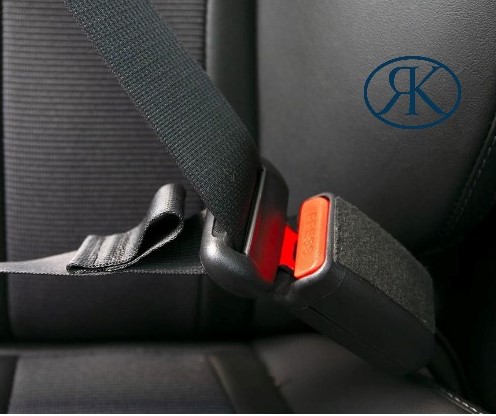
Doing this one thing may save your life while in a car
FALSE ASSUMPTIONS ABOUT MOTOR VEHICLE CRASHES AND WHY SEATBELTS ARE IMPORTANT
Many people, if not almost all, believe most crashes that result in deaths happen at high speeds and well away from our homes. Wrong. The facts do not support these assumptions or beliefs. Rather, the data shows that 80% of deaths occur in cars traveling less than 40 miles per hour, and 75% of crashes occur within 25 miles of our homes.
Louisiana law makes it mandatory for all drivers and passengers in cars, vans, and pickup trucks to wear seatbelts. Wearing a seatbelt reduces the risk of serious injury and death by 50%. Those less likely to wear them are teens, commercial drivers, males in rural areas, pickup drivers, people driving at night, and people who have been drinking. The bottom line is simple. “Buckle up.” Studies show that wearing a seatbelt is the smartest move that drivers can make to prevent injury or death. Here are some facts:
- Your chances of being killed are 25 times greater if you are thrown from your vehicle.
- Non-belted fatalities have been recorded at speeds as low as 12 miles per hour.
- The force of an impact at just 10 miles per hour is equal to the force of a 200 pound bag of cement dropped from a first story window.
- If everyone who is involved in a crash wore a seatbelt at the time of the crash, 60% more lives could be saved.
- 1 in 7 adults choose not to wear seatbelts.
Concerning children, the Louisiana Child Passenger Restraint law requires that all children must be properly restrained and secured in an age- or size-appropriate passenger restraint system that meets the applicable federal motor vehicle safety standards. Here is that information:
- A child 6 years or younger or under 60 lbs. may not be transported in the front seat of a vehicle with an active airbag.
- Birth or less than 20 lbs. at any age – rear-facing, federally approved car seat
- 1-4 years, at least 20 lbs. but less than 40 lbs. – forward-facing, federally approved car seat
- 4-6 years, at least 40 lbs. but less than 60 lbs. – booster seat with restraints
- 6 years, more than 60 lbs. – booster seat with restraints or seat belts
- Booster seats are an appropriate option for a child of any age.
If you remember one thing it is wearing seatbelts saves lives and reduces the risk of serious injuries. To repeat, “Buckle up” and make sure that your passengers and children also are buckled up and in proper restraints.
If you have been injured in a crash and have questions, call us today! The sooner we meet, the faster we can evaluate your case and, if you choose to hire us, the faster we can begin to help you maximize your recovery.
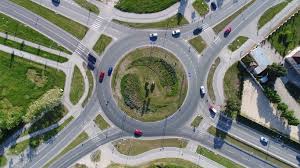
Don’t Get Turned Around in A Roundabout
Roundabouts are also called traffic circles. Roundabouts are one-way, circular intersections designed to improve safety and efficiency for motorists, bicyclists, and pedestrians. In a roundabout, traffic flows counterclockwise around a center island. A roundabout redirects some of the conflicting traffic, such as left turns, which cause crashes at traditional intersections. This is because drivers enter and exit the roundabout through a series of right-hand turns.
Roundabouts replace regular intersections. They do not have stop signs, which eliminates the cost of electric traffic signals. Drivers must yield when entering and exiting a roundabout and must travel in a counterclockwise direction. Greater safety is achieved primarily by slower speeds and the elimination of more severe crashes and operation is improved by smooth-flowing traffic with less stop-and-go than a signalized intersection. Aesthetics are enhanced by the opportunity for more landscaping and less pavement, according to the DOTD. Roundabouts were first introduced in the U.S. in the 1990s. And since September 2003, some 174 more have been built in Louisiana according to the DOTD.
While intended to improve traffic flows and increase safety, roundabouts do not eliminate all traffic crashes. Many of the roundabout crashes are caused by drivers who are unfamiliar with them and the traffic rules that govern them. It is important to know that roundabouts may have two or more lanes, so know which lane you need before you enter the traffic circle.
Common Reasons for Crashes At Roundabouts
- Failure to yield to traffic that is already in the circle.
- Failure to yield to bicyclists and pedestrians.
- Drivers who stop abruptly in the circle because they are confused or missed their turn.
- Speeding when entering the circle.
Preventing Roundabouts Crashes
You cannot control the actions of other drivers. But if you obey some basic rules for roundabouts, you can help prevent a wreck:
- Slow down as you approach a roundabout.
- Yield to traffic that is already in the roundabout.
- Use your turn signal when exiting the roundabout.
- Give trucks and larger vehicles enough space to maneuver and exit the roundabout.
- Do not stop once you are in the traffic circle.
- Know which exit you need to take before you enter the circle.
Roundabout Crash Legal Timeline
Under Louisiana law, an crash victim has one year from the date of injury to file a lawsuit or, if possible, settle the case. When this one-year period expires, the crash victim loses the right to sue the wrongdoer for both economic and non-economic damages.
If You Need An Experienced Attorney
Call us today. We have been helping those injured for over 50 years. We work for our clients, explaining the laws that protect them, the laws that were broken, understanding the facts and our client’s injuries and how those injuries have impacted their daily lives, their goals, and their dreams. So, if you need a great lawyer, call us at (337) 232-1934 to get started.

A Quick Summary of Louisiana Auto Insurance
Here is a quick summary of car insurance in Louisiana.
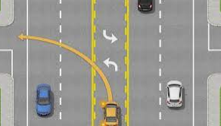
Are you using a center turn lane wrong
CENTER TURN LANE
Some two-way streets have a center turn lane, which makes it easier for vehicles to either turn or move into one of the travel lanes. The center turn lane is located between lanes of opposing traffic and is bounded on each side by one solid yellow line and sometimes times by a broken yellow line. These lines mean that the center lane is not a travel lane. A motorist may turn into it briefly while looking to either merge with the traffic or turn left onto another street.
The Louisiana Driver’s Guide “D” and “E” states, in part, that “There is something called two-way left turn channelization markings, and they are combinations of solid yellow and dashed yellow lines that are in the center of the roadway. The designated center lane, a center lane that is designated in this way may be used by vehicles traveling in either direction for left turn maneuvers only and this lane must never be used for passing.”
A motorist who wants to turn left from the center lane must activate the vehicle’s left turn signal and then wait until there is a large enough gap between the vehicle and oncoming traffic before turning left or merging into a regular lane. If a motorist wants to merge into traffic on the right, a right turn signal must be activated and, when there is an adequate gap in the traffic, only then can the motorist move.
A motorist may not drive a vehicle in the center turn lane for more than 200 feet while waiting to turn left or merge into the adjacent travel lanes or to reach a dedicated left-turn lane at an intersection. A vehicle in a dedicated left-turn lane at an intersection shall turn at the intersection only as designated by posted pavement marking, signing, or traffic signal indication.
You May Need A Lawyer To Recover Your Damages
Under Louisiana law, an accident victim has one year from the date of injury to file a lawsuit or, if possible, settle the case. When this one-year period expires, the accident victim loses the right to sue the wrongdoer for both economic and non-economic damages.
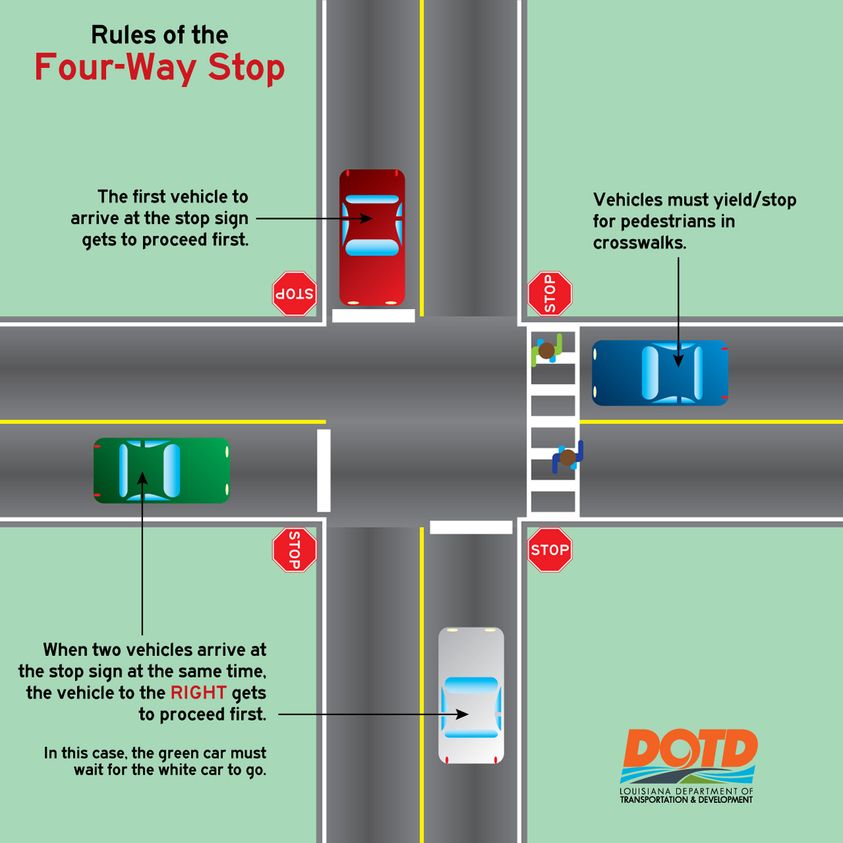
4-Way Intersections: Who Goes First?
Do you know what to do when you get to a 4-way intersection? Generally, they are marked with a Stop Sign for each approaching vehicle. The Stop Signs take the place of an electric control light. Motorists often get confused at these intersections. BEWARE! Many motorists don’t know the simple rules that apply to 4-way intersections or they just disobey them. Motorists often get confused at these intersections, but the rules are really quite simple.
Here are FOUR SIMPLE RULES:
Rule 1: First to arrive, first to drive. When you’re approaching a 4-way stop, drivers who stopped before you have the right of way. If two or more vehicles reach the intersection at the same time, the driver on the left must yield to the driver on your right.
Rule 2: Right-of-way goes to the right, so if two vehicles arrive at the same time, stop, and the car on the right has the right-of-way.
Rule 3: Straight doesn’t have to wait. If 2 vehicles arrive at the same time and are across from each other, stop and watch in which direction the other vehicle is going. If it goes straight, it’s safe for you to go straight because you won’t cross each other’s path. If you are turning, then the car that is going straight has the right-of-way.
Rule 4: Left turn yields to the right. If two vehicles arrive directly across from each other at the same time and both are turning, then the vehicle that is turning left yields to the one that is turning right. These are COMMON SENSE rules. Know them, follow them, and you’ll be safe.
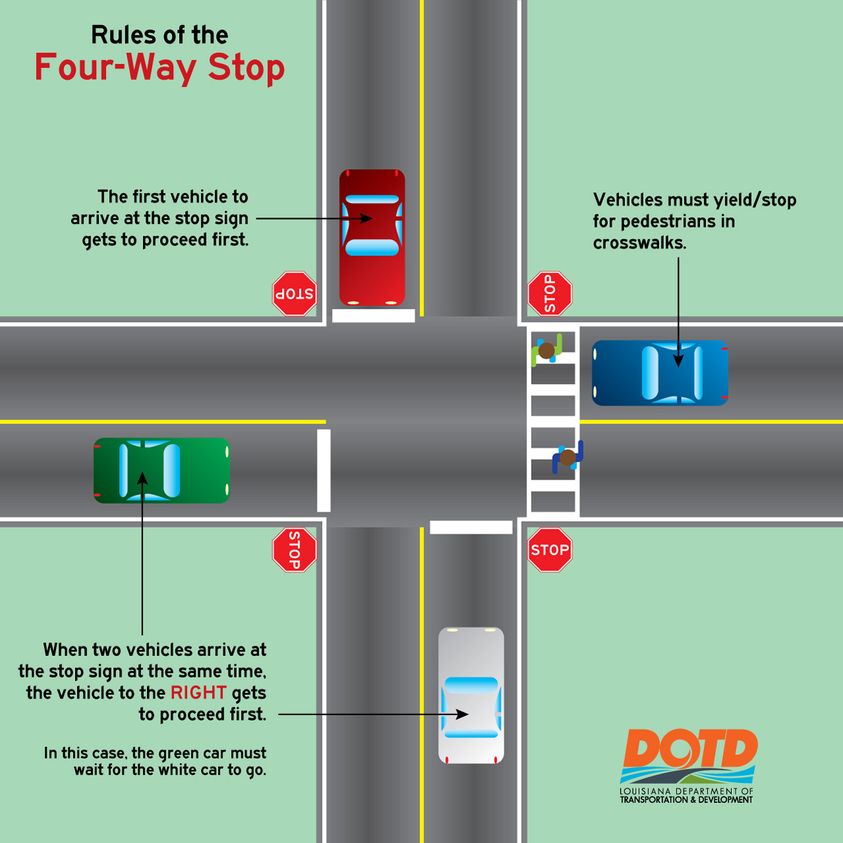
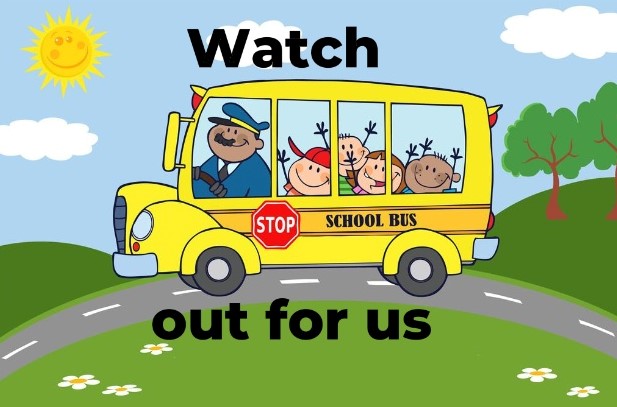
What do you need to know about school buses?

Every day across the country, nearly 500,000 buses carry more than 25 million students to and from school and school-related activities.
School buses are the safest vehicles on the road, and one of the safest modes of transportation overall. In fact, children are much safer traveling in school buses than in any other vehicle, whether they’re going to and from school, a field trip, or a sporting event. They are even safer riding in a school bus than in a car with their parents or caregivers.
Louisiana School-Bus Laws
Motorists must stop at least thirty feet from a stopped school bus that is loading or unloading children. All 50 states have a law that makes it illegal to pass a school bus that is loading or unloading children. Always be prepared to stop when lights are flashing. Bus drivers will activate the flashing yellow lights of the bus at least 100 feet but no more than 500 feet before the school bus stop. As the bus comes to a complete stop, the flashing red lights and stop signs will activate. The motorist waits for the vehicle to move and scan before starting to drive again. This is required by law whether you are meeting the bus or traveling behind it. Every state has a law making it illegal to pass a school bus that’s stopped to load or unload passengers with its red lights flashing and stop arm extended. Far too many drivers simply choose to ignore the law for their own convenience and put children at risk.
You do not have to stop when the bus is stopped in a loading zone completely off the roadway and where pedestrians are not allowed to cross the roadway. If you are following a bus, increase your following distance in order to get a better view. Anticipate the bus stopping at its pickup and drop off points. Never pass a bus with its red lights flashing on the right or on the left. Buses typically travel at lower rates of speed and make frequent stops. During the school year school buses are most likely to be on the road during a three-hour period in the morning and a three-hour period in the afternoon.
When a school bus is stopped in opposite lanes on a roadway separated by a ditch, grassy median, elevated concrete barrier or any obstacle that prevents traffic from driving thereon, you are not required to stop. Drivers are also not required to stop for a stopped school bus when traveling on four-lane or five-lane roadways which are separated by a dedicated two-way left turn lane. Drivers must stop on a four-lane roadway when it is not separated by a barrier.
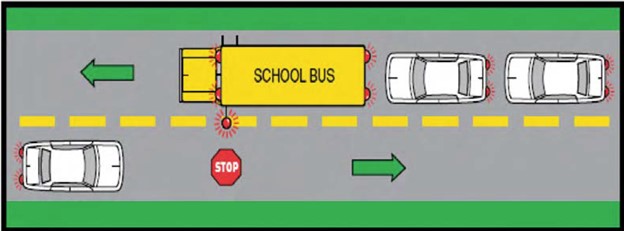
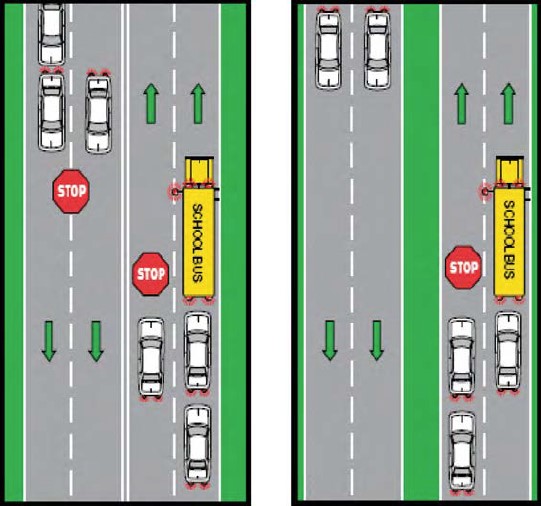
School Bus and Automobile Crashes
Bus crashes can be serious. According to the U.S. Department of Energy, an empty car can weigh up to 5,000 pounds, while an empty school bus can weigh up to 14,500 pounds. This disparity may increase if the bus is at full capacity. What does this mean? Colliding with a school bus versus a passenger vehicle could mean you might sustain more serious personal injuries and more extensive damage to your vehicle. You may have to deal with injuries, such as:
Concussions or traumatic brain injuries (TBIs);
Whiplash
Back pain
Damage to or loss of extremities
Mental trauma
Death
Such injuries can result in both economic and non-economic damages. Typical examples of economic damages are wage losses, job loss, medical expenses, and funeral costs. Typical examples of non-economic damages are physical pain and suffering, emotional pain and suffering, loss of enjoyment of life, and disfigurement. In short, economic damages can be quantified. Non-economic damages cannot be quantified; they are subjective and subject to speculation. No ever person is the same, so non-economic damages vary from person to person.
You May Need A Lawyer To Recover Your Damages
Under Louisiana law, an accident victim has one year from the date of injury to file a lawsuit or, if possible, settle the case. When this one-year period expires, the accident victim loses the right to sue the wrongdoer for both economic and non-economic damages.
Most people have no experience with the legal system and dealing with insurance companies. It is important to know that there are two Points of View (POV). The accident victim wants Justice, meaning full compensation. The insurance company wants to pay the injured person as little as possible for damages. So if you need an attorney, you want one who cares about you, who spends time getting to know you, who keeps you informed about your case, who spends the necessary time to explain the law, and who know what evidence is needed to prove all of your damages.
At the Law Offices of Richard R. Kennedy, you will have Richard Kennedy and Richard Kennedy III to represent you. Why is this important? Because you will know who is representing you; you know that we will keep you timely informed about your case and all the information you need for us to do our very best to get justice for you. When you call us, we answer your calls and we promptly answer your emails. The bottom line is simple: we and our clients get to know each other on a personal — not just a professional — level. That is critical in building trust. So, if you need a lawyer, call us at (337) 232-1934 to get started.
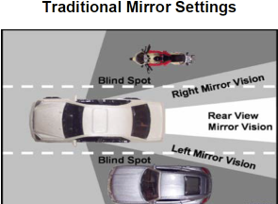
Do you know your blind spots? The importance of rear view mirrors.
REAR VIEW MIRRORS AND BLIND SPOTS
Every vehicle — sedan, SUV, truck, whatever, has one or more blind spots. That’s why vehicles are equipped with rear view and side mirrors. More modern vehicles have driver-alert monitoring, lane change monitoring, and more. But these devices are no substitute for knowing where the blind spots are on your vehicle and how to avoid having a wreck because you failed to know about them and how to successfully deal with them.
In 1995, the Society of Automotive Engineers (SAE) published a research paper that recommended how you should adjust your side and windshield rearview mirrors to eliminate blind spots. That research showed that you should adjust the side mirrors as far outward as you can so that the viewing angle of the side mirrors just overlaps the view of the center rearview mirror. In this manner, you use the center rearview mirror to see what is coming up from behind, while the outside mirrors reflect the area outside the view of the center rearview mirror.
Here is the proper way to adjust your mirrors:
First, adjust your rearview mirror so that it frames the rear window. You should be able to see traffic flow to the rear of the vehicle with the rearview mirror.
Second, place your head against the driver’s side window and adjust the driver’s side mirror so you can barely see the driver’s side of your vehicle.
Third, move your head as close to the center of the car as possible and adjust the passenger side mirror so you can barely see the passenger side of your car.
Fourth, To test your adjustments, watch a car pass you in the next lane. The passing car should be seen in your side mirror before it fully leaves the center rearview mirror. You should also detect the passing car in your peripheral vision before it leaves the outside rearview mirror. Always remember that the center inside rearview mirror is the primary mirror. Although it may take time to get used to not seeing the sides of your car in the side mirrors, it is very important for your rear-view mirrors to be in the correct position so that you can see as much as possible of the traffic behind you as well as those that might be in your blind spot.
You May Need A Lawyer To Recover Your Damages
Under Louisiana law, a crash victim has one year from the date of injury to file a lawsuit or, if possible, settle the case. When this one-year period expires, the crash victim loses the right to sue the wrongdoer for both economic and non-economic damages.
We are a boutique law firm consisting of Richard Kennedy and Richard Kennedy III. Is this important to you? You bet. Why? Because you will know who is representing you, we will keep you timely informed about your case and all the information that you need for us to do our very best to get justice for you. We answer our clients’ calls and promptly answer their emails. The bottom line is simple: we and our clients work as a team and get to know each other on a personal — not just a professional — level. That is critical in building trust. So, if you need a lawyer, call us at (337) 232-1934 to get started.
